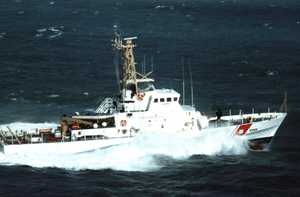Deepwater moves full speed ahead

In February, the Coast Guard boosted one of its workhorse cutters, the 110-foot-long Matagordo, out of the water and onto blocks -- the better to slice it in half.
In February, the Coast Guard boosted one of its workhorse cutters, the 110-foot-long , out of the water and onto blocks -- the better to slice it in half.The is undergoing major surgery. Work crews at Bollinger Shipyard in Lockport, La., are inserting a cross-section into the hull, stretching the length of the cutter by 13 feet, putting in a new deckhouse, new berthing compartments for a larger crew and overhauling all the electronics. The work is scheduled for completion in November.Now, imagine doing that 48 more times.The conversion process for the Coast Guard's entire fleet of 110-foot patrol boats is just one of the first milestones in the 20 to 30-year schedule for Deepwater, the $17 billion overhaul of the maritime service's entire infrastructure. The Integrated Deepwater Project contract was awarded in June 2002 to Integrated Coast Guard Systems, a joint venture between Lockheed Martin Corp. and Northrop Grumman Corp. The team will modernize the Coast Guard's ships, aircraft, communications networks, electronics and other information technologies. It also will add a host of unmanned aerial vehicles and sensors, leading to a level of interoperability and information sharing that doesn't exist today.[IMGCAP(2)]But Coast Guard advocates, including Commandant Adm. Thomas Collins and Rear Adm. Patrick Stillman, program executive officer for Deepwater, want to accelerate the acquisition schedule. Speeding up the program to a 10-year goal would lower the overall cost by almost 25 percent, they said."Stretching" the legacy cutters, for instance, is an interim measure to extend their lives and improve their usefulness until 2018, when a new Fast Response Cutter -- bigger, faster and with a longer maximum travel range -- is scheduled for service. If the new cutter is accelerated, then the conversion of the legacy patrol boats could be modified, depending upon the assessment of resource needs.There is some support on Capitol Hill for moving up the Deepwater schedule, and it appears to be growing. Earlier this month, the House Transportation subcommittee on Coast Guard and maritime transportation unanimously approved an authorization bill that included $702 million for Deepwater: $500 million for the plan, and $202 million beyond President Bush's fiscal 2004 budget request.On the Senate side, the Coast Guard in March released a study requested by Sen. Olympia Snowe, R-Maine, chairwoman of the Senate Commerce subcommittee on oceans, fisheries and Coast Guard. The study found that the total price for Deepwater would be $4 billion lower if the program were accelerated to a 10-year time line.Snowe is pushing for more funding because "she believes the Coast Guard provides a major security benefit to our ports, to commerce, to recreational fishing, recreational boating -- all of which are important to Maine," said spokeswoman Elizabeth Wenk.Sens. Susan Collins, R-Maine, chairwoman of the Senate Governmental Affairs Committee, and Joe Lieberman, D-Conn., ranking member, have joined in support of the accelerated implementation. In a letter to the Senate Budget Committee, they noted "two alarming trends" the study documents: a decline in the readiness of aging Coast Guard resources and an increase in maintenance costs."Replacing older, less reliable ships and aircraft in the near term will allow the Coast Guard to better balance its burgeoning homeland security role with its traditional maritime responsibilities," the senators wrote.Stillman agreed, saying that converting the 110-foot cutters has revealed that their hulls are in worse condition than expected. Scott Truver, group vice president for national security studies at Anteon International Corp., which is assisting the Coast Guard on a number of fronts, said that some of the hulls "have been beaten up so badly that the hulls either will have to be replaced or significantly strengthened."For years, perhaps decades, the Coast Guard was the orphan branch of the military services: part of the Transportation Department and an afterthought in resources and importance to other agencies in the department. Deepwater represents the first significant capital investment project for the service in 30 years."It was undeniably a very tough neighborhood with the Federal Aviation Administration [and] Amtrak," Stillman said.But the terrorist attacks of Sept. 11, the increased importance of protecting U.S. borders and the creation of the Homeland Security Department, which includes the Coast Guard, have combined to give the service an unprecedented opportunity to remake itself."The Coast Guard's move to Homeland Security and the administration's strategy for homeland defense has made the Coast Guard [an integral part] of the plan," Stillman said.Under the program, Northrop Grumman Ship Systems is responsible for all ships and the systems to support them, said Jamie Anton, executive vice president for the joint venture between Lockheed Martin Naval Electronics and Surveillance in Morristown, N.J., and Northrop Grumman Ship Systems in Pascagoula, Miss.Lockheed Martin has the air domain -- fixed-wing aircraft, helicopters and unmanned aerial vehicles -- plus the command, control, communications, computers, intelligence, surveillance and reconnaissance elements, he said. Over the course of the project's life, there are more than 30 different integrated product teams, Anton said, each with a very specific charter and life cycle."We knew we needed a systems integration approach" to Deepwater, Stillman said. This project has always been seen as the creation of a system of systems, with information technology at the heart of the Coast Guard's mission to overhaul its capabilities. "We looked at the force multiplication IT can bring," he said.One subcontractor heavily involved in Deepwater is L-3 Communications Corp., New York. L-3 is responsible for coordinating and putting in place network-centric communications for air, surface and ground platforms, said Frank Lanza, chairman and chief executive officer, creating a much needed intranet for Coast Guard communications."It's been Band-Aided up to now," Lanza said.All those involved in Deepwater recognize the risk in taking on a project of this magnitude, particularly by a service that has never before handled something so complex."The Coast Guard has never entered into a program even close to this magnitude," Lanza said. "Does the Coast Guard really have the facilities and the resources to manage something in the $15 billion to $17 billion bracket? The military has a hard time doing that."Stillman said this is a daunting challenge for the service, whether it's accelerated or not."You will never expunge the risk from any acquisition," he said, but "you'll never expunge risk from operational responsibilities, either. ... The need is real, and the time is now." *Staff Writer Patience Wait can be reached at pwait@postnewsweektech.com.

 Coast Guard looks to accelerate funding for modernization program
Coast Guard looks to accelerate funding for modernization program
Matagordo
Matagordo

The Coast Guard Cutter Matagordo, shown off the coast near Miami Beach, Fla., is the first of the service's 49 patrol boats to be overhauled under the Deepwater project. The conversion will add 13 feet to each cutter, and includes an overhaul of all electronics.
Ed Swift/USCC

"The Coast Guard's move to Homeland Security and the administration's strategy for homeland defense has made the Coast Guard [an integral part] of the plan." ? Rear Adm. Patrick Stillman
Olivier Douliery
Matagordo
Matagordo
NEXT STORY: Who's on first

